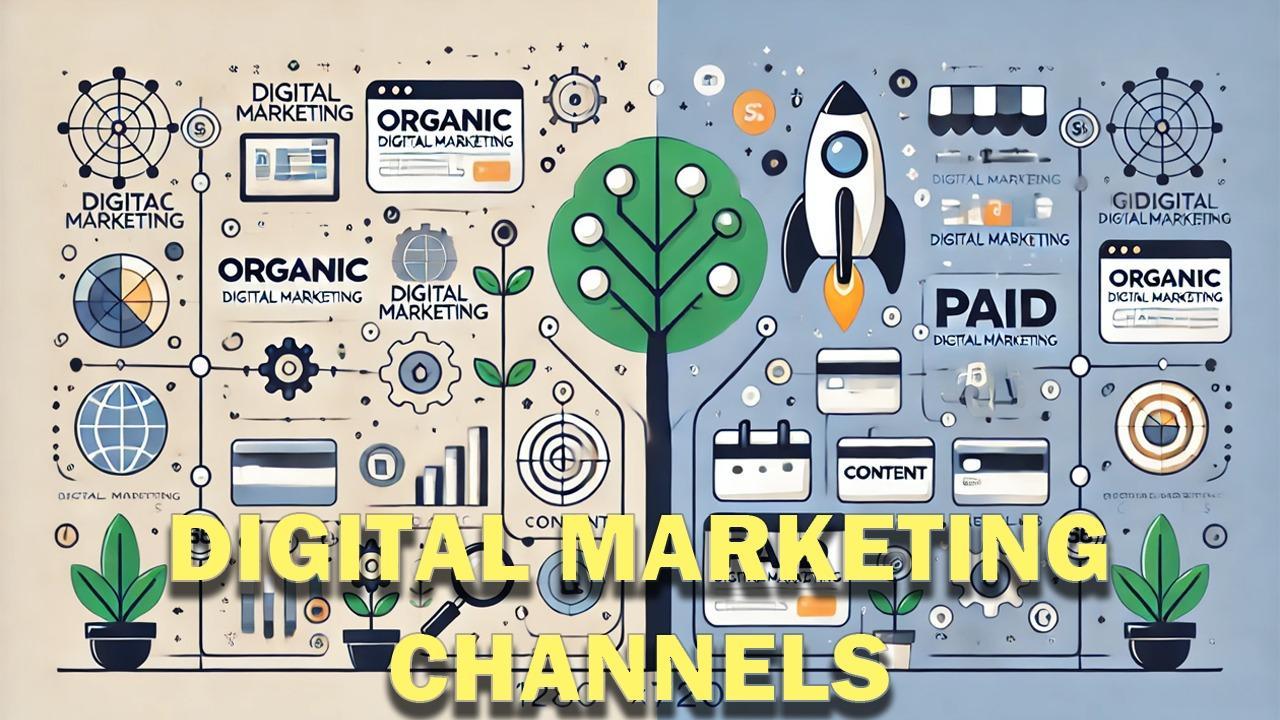In the previous articles in This Series: Digital Marketing Zero-to-Hero, we have learned about marketing and now its time to learn about implementation. What are the different types of channels where we can execute our digital marketing strategies? We will discuss about organic and paid channels, some tips for choosing right channel for your digital marketing strategy and tips for integrating and managing multiple channels.
There are two types of digital marketing channels
Organic Digital Marketing Channels
Paid Digital Marketing Channels
🔵 Organic Digital Marketing Channels:
Organic digital marketing channels refer to methods and practices aimed at naturally attracting and engaging an audience without direct financial investment in advertising. These channels rely on creating high-quality, relevant content and optimizing online assets to improve visibility in search engines and social media platforms.
🔵 Paid Digital Marketing Channels:
Paid digital marketing channels, on the other hand, involve investing financial resources to promote products, services, or content directly to a target audience. Paid channels encompass various advertising methods, such as pay-per-click (PPC) advertising, display ads, social media advertising, affiliate marketing, and influencer partnerships.
Let’s talk about the differences between both channels in terms of different factors such as: cost, traffic generation, speed, credibility and trust, success, and benefits.
🔷 Organic Digital Marketing Channel:
Organic digital marketing channels are cost-effective in the long run as they don’t require direct payment for ad placements.
It focuses on attracting traffic naturally through strategies like SEO.
It is time-consuming to achieve significant results.
It is more credible and trustworthy among users, as it is based on relevance and quality.
Success heavily relies on high-quality, valuable content.
It has long-term benefits.
🔷 Paid Digital Marketing Channel:
Paid digital marketing channels involve direct financial investments in advertising, and costs can accumulate quickly depending on the platform targeting options.
It provides immediate traffic and results, making it suitable for quick returns on investment (ROI)
Yielding results can be instant and also driving traffic and conversions is rapid.
Paid advertisements may be seen less credible than organic results because it is known to the users that they are promoted.
Success depends on well-desired ads, targeting, and bidding strategies.
It has short-term benefits.
After getting all the differences, you can pick the channel that suits you best for the products or services that your businesses or brands offer.
🔵 Tips for Choosing the Right Channel for Digital Marketing Strategy
While considering the channel is a big question while planning the digital marketing strategy,. Even after knowing the difference, we are unable to figure out which channel will suit us best based on business needs and wants. Let’s break down the structure to figure out which channel will suit the best.
🔷Define Your Goals:
Start by setting clear goals for your digital marketing campaign. Are you looking to increase brand awareness, generate leads, or boost sales? Understanding your objectives will help narrow down your channel choices.
🔷Know Your Audience:
Analyze your target audience thoroughly. Consider demographics, behaviors, preferences, and pain points. Different channels cater to distinct audience segments, so align your choices accordingly.
🔷Understand Channel Strengths
As social media is effective for brand building and engagement, email marketing, on the other hand, is excellent for nurturing leads and maintaining customer relationships. So, understand the strength first, and then choose.
🔷Budget Allocation:
Assess your budget and choose channels accordingly.
🔷Consider Multi-Channel Approach:
In many cases, combining multiple channels can amplify your reach and impact. Just ensure they complement each other and align with your goals.
It will be easy for businesses to decide which channel will suit them best to implement their marketing strategy for their products and services. The multi-channel approach is highly functional, but if implemented correctly,. Let’s look at some tips if any business considers the multi-channel approach, so that the implementation process works smoothly.
9 Tips Managing Multiple Channels
Set a Unified Strategy: Begin with a comprehensive digital marketing strategy that outlines your objectives, target audience, and key messages. Ensure alignment across all channels to maintain a consistent brand image and messaging.
Understand Cross-Channel Synergy: Identify how different channels can complement each other. For instance, use social media to promote your blog content or leverage email marketing to reinforce your social media campaigns. Leverage cross-channel synergy to create a seamless customer journey.
Select an Integrated Toolset: Invest in marketing automation and management tools that allow you to centralize your campaigns, track performance, and manage content across various channels. Popular tools like HubSpot, Marketo, and Hootsuite can help streamline your efforts.
Audience Segmentation: Divide your audience into segments based on their behaviors, preferences, and demographics. Tailor your messaging and content to each segment, ensuring relevancy and engagement across channels.
Content Repurposing: Repurpose your content to suit different channels. For instance, turn a blog post into a video, an infographic, or a series of social media posts. This maximizes the value of your content while catering to various audience preferences.
Consistent Branding: Maintain a consistent visual and messaging identity across all channels. This includes logos, color schemes, and tone of voice. Brand consistency fosters trust and recognition.
Monitor and Analyze: Use analytics tools to track the performance of each channel. Assess key metrics like engagement rates, conversion rates, and ROI. Regularly review your analytics to identify areas for improvement and optimization.
Testing and Experimentation: Run A/B tests and experiments across channels to determine what strategies work best for your audience. Implement successful strategies more broadly, and iterate based on results.
Compliance and Regulations: Stay updated with legal and compliance requirements relevant to each channel, especially regarding data protection and privacy (e.g., GDPR, CCPA).
#digitalmarketing #channels #paiddigitalchannel #organicdigitalmarketing #budget #audience

